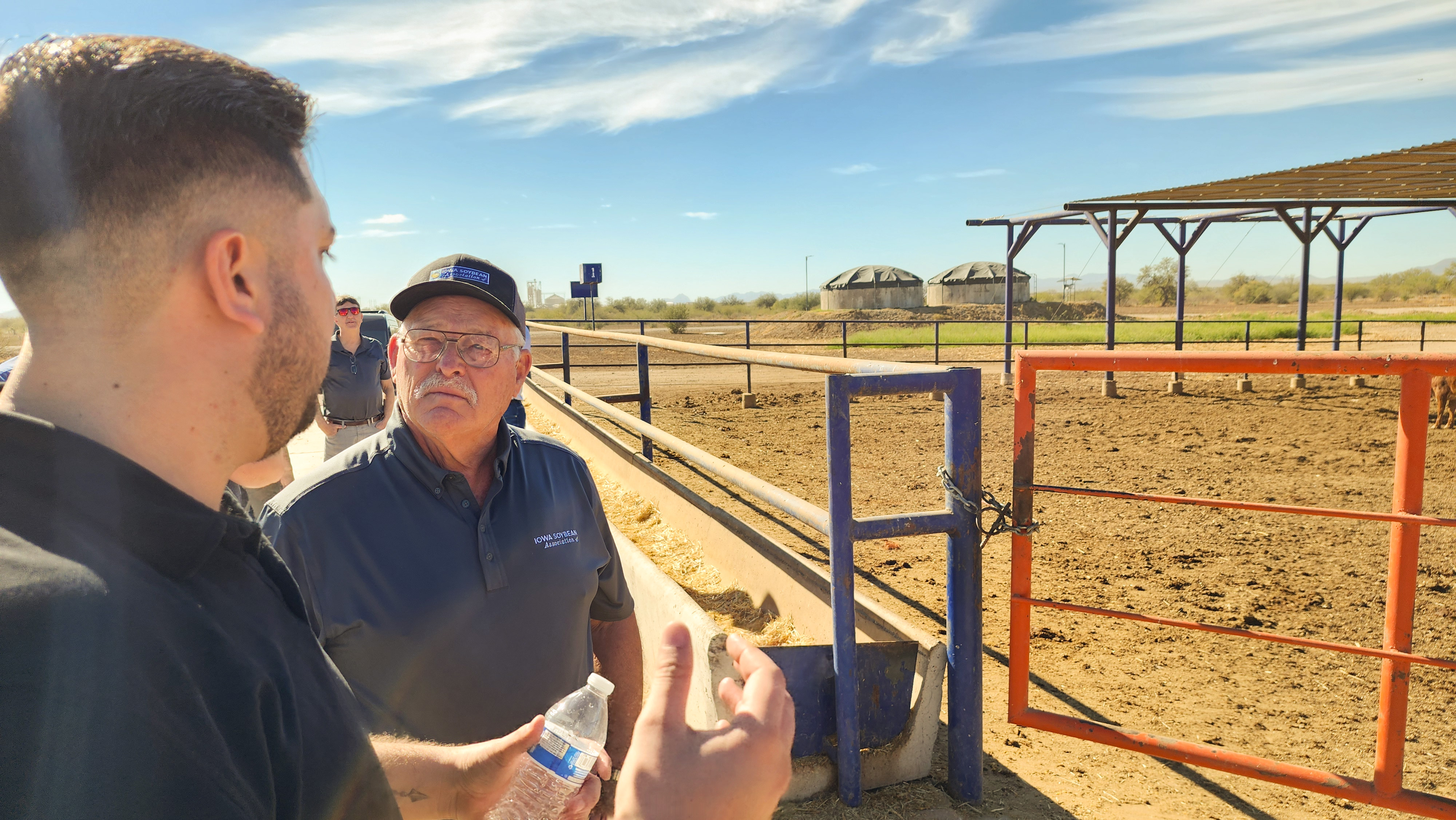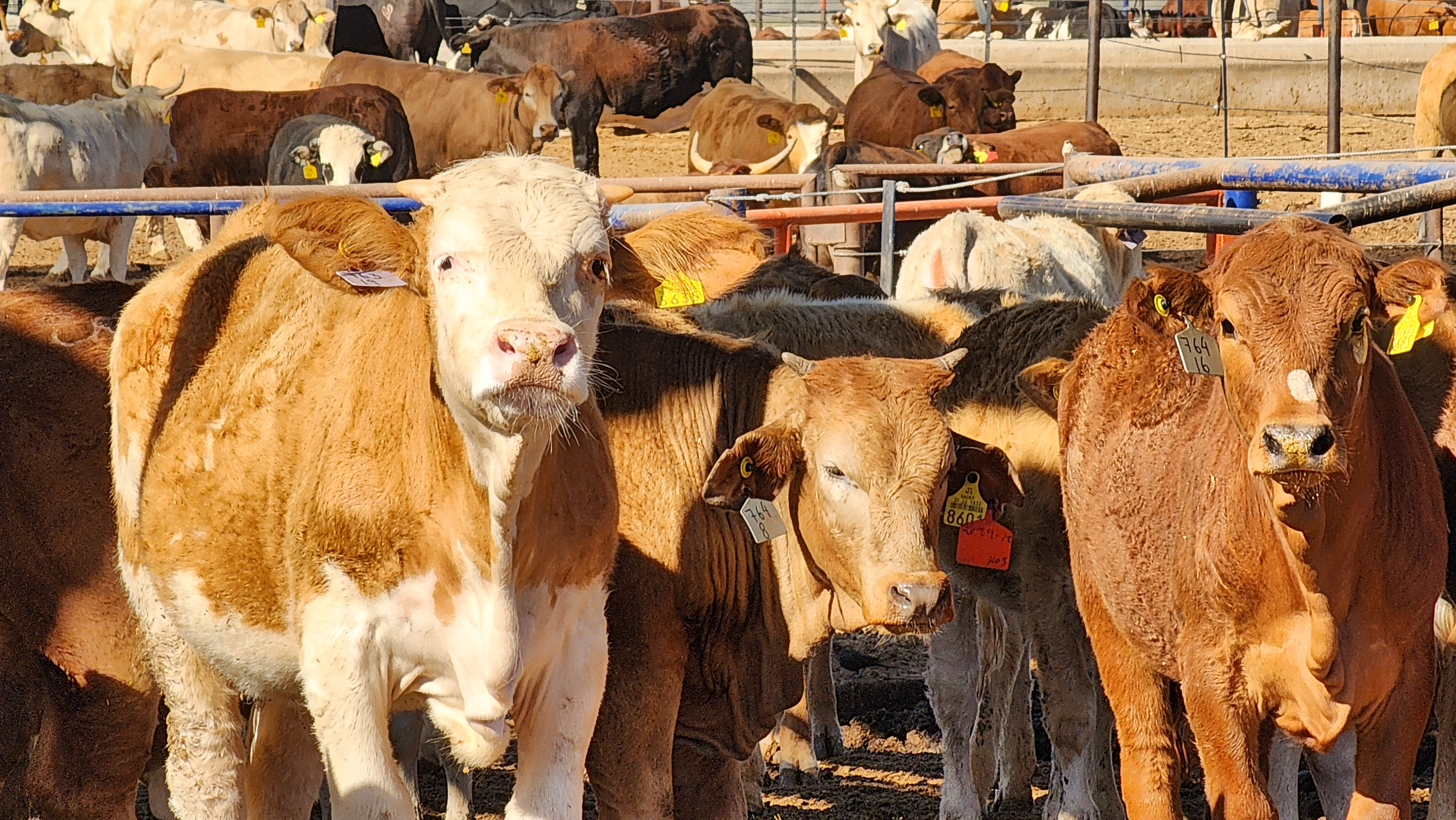
ISA District 8 Director Warren Bachman visits with Cesar Valencia from El 17 during a recent trip to Mexico. (Photo: Iowa Soybean Association / Aaron Putze)
Increasing U.S. soy sales tied to branding success of Mexican beef company
April 30, 2024 | Aaron Putze, APR
A brand has long been used by cattle farmers and ranchers to identify an animal’s original ownership and discourage theft.
Effective branding also differentiates one product from another in the retail marketplace, and the ability of a Mexican beef producer to do it successfully will benefit Iowa and Midwest soybean farmers.
For El 17, a 33-year-old company based in northwest Mexico specializing in the production of high-quality beef, the power of its brand is increasing sales of its premium steaks. It will also be the catalyst for the company’s aggressive expansion of Taste, its retail marketplace featuring cut-to-order butcher shops, ready-to-cook meals, and a variety of popular convenient store offerings.
“People believe in our brand,” says Roberto Loustaunau, the company’s second-generation owner. “Our goal is to keep the brand top of mind as the best quality beef in Mexico.”
The success of El 17 directly impacts the bottom line of U.S. soybean farmers, including those who visited the company’s feedlot and retail stores during a market development trip to Mexico Feb. 18-23. The meetings were arranged by AGP.
Iowa soybean farmers like Warren Bachman pay attention to Mexico as it is America’s second-largest single export market for soy with sales of nearly $4.76 billion. Bachman, an Iowa Soybean Association (ISA) District 8 director, joined fellow soybean farmers and association staff from Missouri, Kansas and Nebraska in the trade mission.
The goal of their time in Mexico: to increase soybean sales south of the border and build upon the 91% market share U.S. farmers have of the country’s 8.2 million metric tons of annual soy imports.
“It’s important to visit your trading partners so you can see firsthand what’s happening with their economy and what they think of your product,” says Bachman, who farms near Osceola and is serving his eighth year on the ISA board. “You got to invest in your customer if you want them to invest in you.”

Adding numbers
That includes major meat producers like El 17. The company’s feedlot, located on the outskirts of Hermosillo (pop. 850,000), sits on 1,000 hectares (roughly 2,500 acres). About one-fourth of it is penned, with a capacity of 19,000 head. The number on feed varies with the economics of cattle production and consumer demand for beef. After declining to just 40% of capacity in 2022, El 17 has returned to 15,000 head on feed.
he goal, says Loustaunau, is to return to producing 19,000 head within a year or two, increasing to 25,000 head within 3-5 years. The growth will meet increasing domestic and international demand for its premium beef cuts and hamburger.
Iowa farmers marketing soybeans through AGP keep close tabs on feedlots like El 17 because its success means more demand for U.S. soy.
Amino Plus, a bypass protein feed formulated and milled by AGP, is a desired feedstock for dairy and cattle. When priced competitively, it becomes an attractive option to dried distillers grain.
Andrew Metzger, senior merchandiser for Omaha-based AGP, makes frequent visits to the country to promote sales of the processor’s soybean meal. That includes Amino Plus, a product high in lysine and amino acids that make it an especially helpful feed ingredient for boosting milk output in dairy herds.
AGP’s work with Mexico began almost 20 years ago. The farmer-owned cooperative continues to network aggressively with feed suppliers and livestock producers to boost demand in Mexico while establishing market share in Panama, Japan, Slovakia, Belgium and Saudi Arabia.
“There’s great potential to increase market share of Amino Plus due to its performance and as it becomes more competitively priced,” Metzger says.
The value of U.S. soybean exports to Mexico has a 10-year average value of $2.09 billion with a growth rate of 53%, according to the U.S. Department of Agriculture. Soybean meal mainly comes from domestic crushers and imports. The core share of soybean oil also goes to domestic crushers, with imports primarily coming from the U.S.
Mexico’s current soy import dynamics reflect developments in the crush industry as key players expand capacities and leverage soybean imports. The U.S. Soybean Export Council says soy and soy products are in high demand in the country of 136 million. The legume accounts for almost two-thirds of Mexico’s total volume of oilseeds processed.
Expansion plans
With Cat front-end loaders continuously moving feedstocks for mixing, Cesar Valencia speaks above the din as he shares the company’s commitment to producing quality beef using quality feed.
As general manager, Valencia oversees the feedlot’s daily operations-from feeding to the overall care of the cattle. Feed ingredient staples include grain, alfalfa, wheat straw, minerals, fats, vitamins and soy. Five formulas of feed are milled on the farm and fed based on the growth rate and dietary needs of the cattle.
U.S. soy is known by El 17 and other livestock producers in the area for its quality. As domestic U.S. crush intensifies to boost oil output, soybean meal and its co-products will become more competitively priced in the global marketplace. And that may be just the price signal that bumps demand in places like Hermosilla and for customers like El 17.
The feedlot’s 50 employees monitor the health of the animals and formulate and mix feed rations to match the maturity and weight of the animals. The continuous attention is warranted as temperatures can spike to 120 degrees June through mid-September. As a result, the breakfast bell rings at 5 a.m. instead of 7, taking advantage of the cooler morning air.
Antibiotics are used in disease prevention but not in feeding. Heifers and steers arrive at the feedlot weighing around 600 pounds, doubling their weight before heading to market.
More than 150 tons of feed are mixed and fed daily at El 17. The feedlot contracts with a third party to remove the manure, which is sold as fertilizer to fruit producers in California.
Loustaunau, who holds a degree in business management, says El 17 provides complete traceability from the feedlot to the client, the latter of which includes upscale steak and seafood restaurants located throughout the country. It also sells to Mexico’s largest supermarkets including Wal-Mart and Soliano and area butchers. Some product is exported to Japan and the U.S.
Consumers rule
But El 17 increasingly prefers selling direct to consumers as more people seek to know the origins and production methods of the food they enjoy. In addition to traceability, the company is known for producing beef of exceptional color, marbling and flavor.
El 17’s retail market expansion seeks to make the most of these brand attributes while boosting its bottom line. Founded nearly 10 years ago, El 17 now operates 25 Taste Boutique de Carnes stores (premium meat products sold locally). Last year’s expansion included six new stores in Mexico City. The company’s goal, says Loustaunau, is to grow by 6-8 new stores annually, with 100 in operation by 2034.
The company’s decision to target Mexico City for expansion was based on online sales growth during the Covid pandemic. Those interactions provided key insights about El 17’s customers and their preferences.
“People know about the brand in Mexico City as half of our online sales (during the pandemic) came from that city,” Loustaunau says.
“We capture the brand value with our stores. They know the brand, the quality and that it’s produced in Mexico. They are confident and like the product. No one else is doing this in Mexico.”
The challenge now, he says, is to fully convert the company’s staff and culture to match its full embrace of retail.
“We’re no longer just raising beef but managing stores to grow sales and our bottom line,” says Loustaunau. “It takes a different kind of team to advance in that market, but we are in a good spot to grow. The time is now.”
Putze serves as ISA Chief Officer of Brand Management & Engagement. Contact him at aputze@iasoybeans.com.
Back